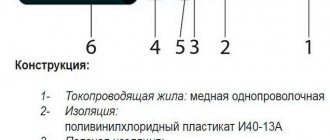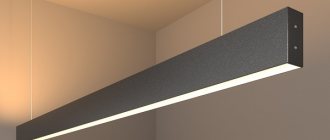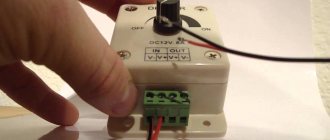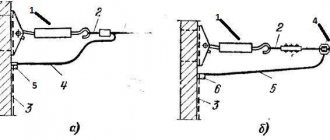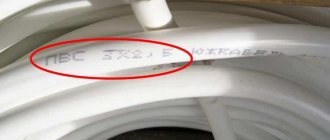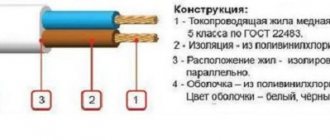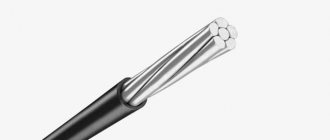Electrician in the house
Encyclopedia about electricity from A to Z
Masters catalog
Find the best master or company in your city
SIP brand wires
There are a huge number of SIP brand wires on the market, which allows you to choose the model that best suits your requirements. This applies not only to standard sizes, but also to wire design. But such diversity also creates some problems.
This is especially true for people who encounter this type of wire not very often, or even for the first time. It is for them that we will consider all the features of its design, and also briefly talk about the areas of application of products of one type or another.
- Classification of SIP type cable products
- Features and explanation of the name Design features of SIP brand wire
- Explanation of the name
- Electrical characteristics
Technical and operational characteristics of SIP wires:
- Rated voltage 0.6/1.0 kV
- Ambient temperature from -50˚С to +50˚С
- Relative humidity 98%
- Minimum operating temperature for laying wire without heating -20°C
- Maximum permissible operating temperature of the cores +90˚С
- Maximum permissible heating temperature of the cores in emergency mode, as well as in overload mode: +130˚С
- Maximum core heating temperature during short circuit +250˚С
- Service life 40 years
Let's look at the range of SIP wires and their characteristics.
Advantages and disadvantages
The advantages of the products include the following characteristics: 1. There is no need to install powerful insulators on the line. 2. Security. Thanks to the insulation, there is no danger for specialists when servicing or installing self-supporting SIP wires. 3. Since the cores are connected by the same insulation, the width of the route is reduced. 4. Products can be used for regions with any weather conditions. 5. Eco-friendly. SIP cables do not affect people or animals. 6. Corrosion resistance. 7. Easy and simple installation of SIP wire. 8. Savings. To maintain and repair a line with exposed aluminum wires, you need to spend a lot of money, several times more than what is required for lines with SIP wires. Of course, there are also disadvantages, which include the large weight of wires of this type. Because of this, there is a need to more often install supports for installing the SIP cable to the house. If the products are used for installation in industrial enterprises, it will be necessary to perform reinforced insulation.
SIP wire 2
The self-supporting insulated wire SIP 2 is made with a zero load-bearing insulated conductor. The insulation of all cores is made of light-stable cross-linked polyethylene. Load-bearing core made of aluminum alloy. The number of current-carrying cores is from 1 to 4. All cores are round and multi-wire. The cores are twisted around the load-bearing wire to the right.
Imported analogues : AXKA-T, AsXSn (Poland), Torsada (France), AsXS.
The nominal values of the current-carrying cores of the SIP 1 and SIP 2 wires are in the table below:
| Nominal cross-section of phase conductor, mm2 | Number of wires in the core, pieces. | Outer diameter of the conductor, mm. | Electrical resistance of 1 kilometer of phase conductor to direct current, Ohm, no more |
| 16 | 1 | 4,35-4,45 | 1,910 |
| 16 | 7 | 4,60-5,10 | 1,910 |
| 25 | 7 | 5,7-6,1 | 1,200 |
| 35 | 7 | 6,7-7,1 | 0,868 |
| 50 | 7 | 7,85-8,35 | 0,641 |
| 70 | 7 | 9,45-9,95 | 0,443 |
| 95 | 7 | 11,1-11,7 | 0,320 |
| 95 | 19 | 11,0-12,0 | 0,320 |
| 120 | 19 | 12,5-13,1 | 0,253 |
| 150 | 19 | 14,0-14,5 | 0,206 |
Nominal values of the zero, supporting conductors of wires SIP 1 and SIP 2, in the table below:
| Nominal cross-section of load-bearing cores, mm2 | Permissible load current, A, no more | Permissible one-second short circuit current, kA, no more |
| 16 | 100 | 1.5 |
| 25 | 130 | 2.3 |
| 35 | 160 | 3.2 |
| 50 | 195 | 4.6 |
| 70 | 240 | 6.5 |
| 95 | 300 | 8.8 |
| 120 | 340 | 10.9 |
| 150 | 380 | 13.2 |
SIP cable fittings
Design of SIP wires
Installation of the wire requires the purchase of additional accessories. They allow you to fix the product on the surface and lengthen it as necessary. All parts must be selected specifically for the selected cable in order to do their job efficiently.
For SIP wire you need the following equipment:
- Piercing clamps. They allow you to connect conductors in such a way that there is no need to remove insulation from the cable.
- Branch details.
- Anchor fastening. Helps secure clamps.
Bandage tape is also used. All necessary components must be resistant to rust, ultraviolet radiation and temperature changes.
Wire SIP 3
Single-core self-supporting wire made of aluminum alloy. The core is multi-wire, round. Core insulation made of light-stable cross-linked polyethylene. When laying, the bending radius of the wire is 10 wire diameters
Analogs: PAS, SAX (Finland)
The permissible current loads of the wires and the permissible one-second short circuit current must correspond to those indicated in the table:
| Nominal cross-section of main cores, mm2 | Permissible load current, A, no more | Permissible one-second short circuit current, kA, no more |
| 35 | 200 | 3,0 |
| 50 | 245 | 4,3 |
| 70 | 310 | 6,0 |
| 95 | 370 | 8,2 |
| 120 | 430 | 10,3 |
| 150 | 485 | 12,9 |
Instructions: how to lay wires yourself
Installation of SIP cables has some features. It is important to carry out the installation in suitable conditions, select the correct components, and also follow the necessary algorithm for installation.
Conditions
The wire is installed at a temperature of -60…+40 °C. It is advisable to carry out work in calm weather. The distance from the pole to the house should not exceed 25 m. If this figure is greater, additional support will be required. It is necessary to do the ending when entering it into the machine.
Required components
When connecting to copper wires, adapter sleeves should be used. Anchor brackets and clamps may be required during operation.
They are selected taking into account the cross-section and other characteristics of the cable. Caps are needed to insulate the ends. If connection to a power line is required, piercing clamps are required.
Algorithm of actions
Installation of SIP includes the following steps:
- installation of supports;
- fixing special hooks or brackets;
- unwinding and hanging the leader cable;
- lifting the SIP and tensioning it;
- fastening the wire to the supports;
- formation of linear branches.
Wire SIP 4
The conductors are aluminum, multi-wire, round. The number of cores is 2-4. The cores are compacted (compacted). The cross-section of the cores is 16-150 mm2. When laying, the permissible bending radius is 7.5 times the diameter of the wire
The permissible current loads of the wires and the permissible one-second short circuit current must correspond to those indicated in the table:
| Nominal cross-section of main cores, mm2 | Permissible load current, A, no more | Permissible one-second short circuit current, kA, no more |
| 35 | 200 | 3,0 |
| 50 | 245 | 4,3 |
| 70 | 310 | 6,0 |
| 95 | 370 | 8,2 |
| 120 | 430 | 10,3 |
| 150 | 485 | 12,9 |
Analogue: NFA2X; ALUS (Sweden).
Cable properties
All technical properties of the wire are regulated by GOST R 52373-2005. According to the described standard, SIP can be used on power lines up to 35 kilovolts. The cross-section should be no higher than 240 sq.mm. In sections of the main power line, the diameter of the main cable must exceed the cross-section of the cores of the branch conductors.
SIP cable is also suitable for creating street lighting. The best option is a product with 25 sq. mm cores.
Basic parameters of the conductor according to the GOST standard:
- Maximum permissible load. Directly depends on the cross-sectional area. Defined in kW.
- Operating temperature limits.
- Permissible humidity limits, resistance to water and ultraviolet rays.
- Temperature limit at critical mode.
- Bend radius.
- Warranty (usually 3 years).
- Lifetime. If the requirements are met, it is 40 years or more.
There may be differences depending on the cable manufacturer. But they must be within the limits established by GOST.
By name, SIP is a wire, but by its characteristics it is a cable.
Diameter of SIP wire cores
No wires for lighting:
| Number of cores and cross-section | Outer diameter of wire, mm |
| 1x16+1x25 | 17 |
| 3x16+1x25 | 22 |
| 3x25+1x35 | 26 |
| 3x35+1x50 | 30 |
| 3x50+1x50 | 33 |
| 3x50+1x70 | 35 |
| 3x70+1x70 | 38 |
| 3x70+1x95 | 41 |
| 3x95+1x70 | 43 |
| 3x95+1x95 | 44 |
| 3x120+1x95 | 47 |
| 3x150+1x95 | 49 |
| 4x25+1x25 | 22 |
| 4x25+1x35 |
With wires for lighting:
| Number of cores and cross-section | Outer diameter of wire, mm |
| 3x25+1x35+1x16 | 28 |
| 3х25+1х35+1х16(ozh) | 28 |
| 3x35+1x50+1x16 | 30 |
| 3x35+1x50+1x25 | 30 |
| 3x50+1x50+1x16 | 33 |
| 3x50+1x50+1x25 | 33 |
| 3x50+1x70+1x16 | 35 |
| 3x50+1x70+1x25 | 35 |
| 3x70+1x70+1x16 | 38 |
| 3x70+1x70+1x25 | 38 |
| 3x70+1x95+1x16 | 40 |
| 3x70+1x95+1x25 | 40 |
| 3x95+1x70+1x16 | 42 |
| 3x95+1x70+1x25 | 42 |
| 3x95+1x95+1x16 | 44 |
| 3x95+1x95+1x25 | 44 |
| 3x120+1x95+1x16 | 47 |
| 3x150+1x95+1x16 | 50 |
| 3x120+1x95+1x25 | 47 |
| 4x25+1x35+1x16 | 29 |
| 3x25+1x35+2x16 | 28 |
| 3x25+1x54.6+2x16 | 30 |
| 3x25+1x54.6+2x25 | 30 |
| 3x35+1x50+2x16 | 30 |
| 3x35+1x54.6+2x16 | 32 |
| 3x35+1x54.6+2x25 | 32 |
| 3x50+1x50+2x16 | 33 |
| 3x50+1x54.6+2x25 | 35 |
| 3x70+1x70+2x16 | 35 |
| 3x70+1x54.6+2x16 | 38 |
| 3x70+1x54.6+2x25 | 38 |
| 3x70+1x70+2x16 | 38 |
| 3x70+1x95+2x16 | 40 |
| 3x95+1x70+2x16 | 42 |
| 3x95+1x95+2x16 | 44 |
| 3x120+1x95+2x16 | 47 |
More articles
- The importance of calculating cable cross-section
- Recessed ceiling LED lights
- Cable channels of open wiring in residential and office premises
- NUM cable, description, application
- Flexible power cable KG: description, characteristics, purpose
- What cable trays are used in electrical installations?
- Terminal blocks for DIN rail: classification, photo
- Distribution box: description, types and types of distribution (junction) boxes
- Mounting boxes for electrical installation: classification and types
- Electrical trays: description, use, regulatory documents
Installation features
fasteners
are a framework that is used primarily for conducting electrical lines in the open air. The connection is made via a centralized line.
To independently connect and install the cable, you must obtain permission from the relevant organizations involved in energy supply. It is mandatory to develop a project plan indicating the conductors used. To work, you will need professional equipment.
The wire is inserted using piercing clamps. After this you need to connect the tips. Hanging is carried out using cables that are stretched between the posts (for lengths over 25 meters). To install the cable on poles, holders are made.
If you need to stretch a cable along the facade of a building, anchors are used. Their number must correspond to the number of input cores. The cable can be inserted into the house no more than 1 meter, after which the wiring is carried out inside the building. If the house material is non-flammable, the cable on the wall is laid in an open way. This can be done in a corrugated pipe or plastic box.
For air laying, the SIP grade 2x16, 4x16 is used. The first is also used to branch lines indoors and connect to machines and meters.
Explanation of SIP markings
In comparison with other brands, SIP wire is a current-carrying element for transmitting electricity, which is deciphered by the three letters of the name:
- C – means that the wire is self-supporting;
- And - indicates the presence of insulation around current-carrying conductors;
- P - indicates that this is a wire, despite the presence of an insulating coating and branching along the cores, which is why it can be equated to a cable.
Consider an example of such a designation - SIP-1-3×20+1×25-0.4, here SIP-1 indicates the brand, 3×20 indicates that three insulated cores have a cross-section of 20 mm 2 each, 1×25 means that the neutral core has a cross-section of 25 mm 2, 0.4 is the rated voltage for this model.
Depending on the specific brand, there are five main types of SIP wire, designated by the corresponding numbers after the letter designation. There may be one letter at the end, indicating design differences and operational features. These differences in SIP brands are determined by design parameters, so it would be more appropriate to consider them using specific examples.
PUE table for calculating cable cross-section by power and current
Allows you to select the cross section based on the maximum current and maximum load.
for copper wires:
for aluminum wires:
Formula for calculating cable cross-section by power
Allows you to select the cross section based on power consumption and voltage.
For single-phase electrical networks (220 V):
I = (P × K and ) / (U × cos(φ) )
- cos(φ) - for household appliances, equals 1
- U - phase voltage, can range from 210 V to 240 V
- I - current strength
- P - total power of all electrical appliances
- K and - simultaneity coefficient, for calculations the value is taken as 0.75
For 380 in three-phase networks:
I = P / (√3 × U × cos(φ))
- Cos φ—phase angle
- P is the sum of the power of all electrical appliances
- I is the current strength by which the cross-sectional area of the wire is selected
- U - phase voltage, 220V
Application
SIP-1 - for mains of overhead power lines (OHT) and linear branches from overhead lines in air atmosphere of types I and II according to GOST 15150-69.
SIP-2 - for the mains of overhead power lines (OHT) and linear branches from overhead lines in the air atmosphere of types I and II according to GOST 15150-69, including on the coasts of the seas, salt lakes, in industrial areas and areas of saline sands.
SIP-3 - for overhead lines with a rated voltage of 10-35 kV in an air atmosphere of types II and III according to GOST 15150-69, including on the coasts of the seas, salt lakes, in industrial areas and areas of saline sand.
SIP-4, SIP-5 - for branches from overhead lines to the input and for laying along the walls of buildings and engineering structures in an air atmosphere of types II and III according to GOST 15150-69.
How many kilowatts can SIP withstand - table:
SIP section
| voltage 380V (3-phase load) | voltage 220V (1 phase load) | |
| SIP 4x16 | 62 kW | 22 kW |
| SIP 4x25 | 80 kW | 29 kW |
| SIP 4x35 | 99 kW | 35 kW |
| SIP 4x50 | 121 kW | 43 kW |
| SIP 4x70 | 149 kW | 53 kW |
| SIP 4x95 | 186 kW | 66 kW |
| SIP 4x120 | 211 kW | 75 kW |
| SIP 4x150 | 236 kW | 84 kW |
| SIP 4x185 | 270 kW | 96 kW |
| SIP 4x240 | 320 kW | 113 kW |
Production and sales
There are many cable manufacturers, and only the consumer can decide which wire to choose specifically from all the varieties. As for quality, it cannot be said that any of the large domestic or foreign manufacturers are significantly higher or lower in this indicator.
All requirements for SIP wires are presented in the relevant GOST, and if the products of a particular enterprise do not comply with it, they simply will not reach the market.
The manufacturer directly carries out mainly wholesale cable sales; for small volumes you will have to resort to the services of dealers or intermediaries. And decent companies are always ready to provide documentation confirming their cooperation with one or another manufacturer, as well as evidence of the quality of the product.
Do you want to buy a cable?
You can check availability and prices with us! Leave a request for a call back
